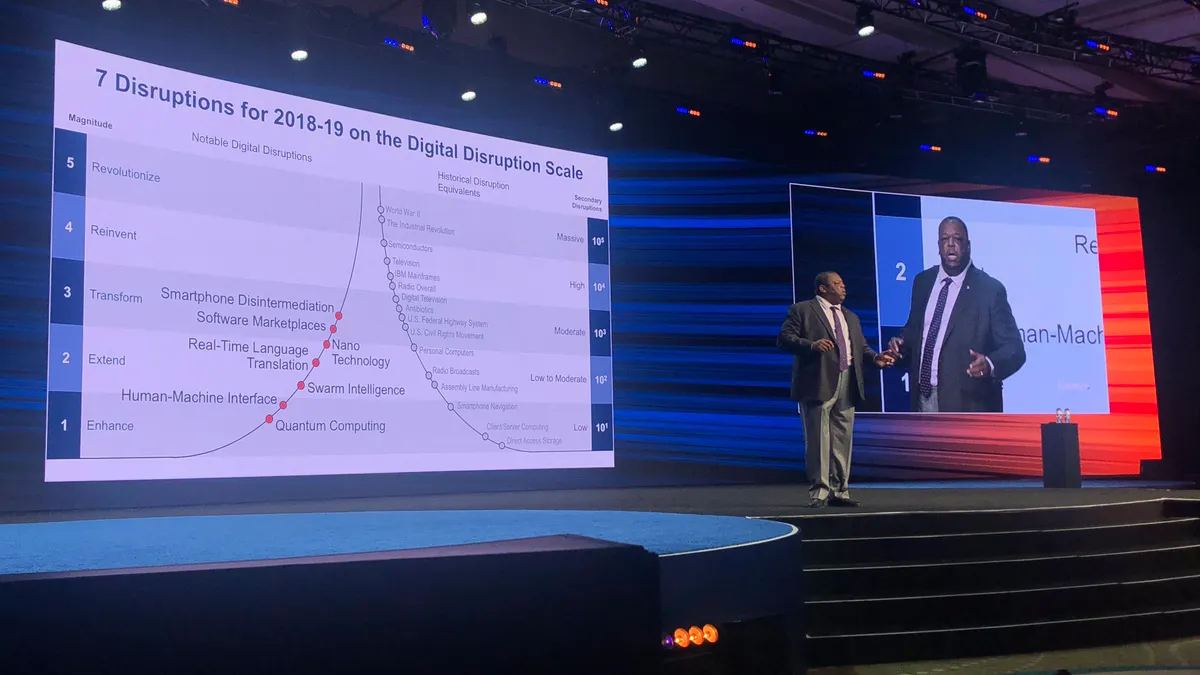If disruptive technologies scare CIOs, they should talk to an analyst. If disruptive technologies do not scare CIOs, they should talk to an analyst.
"The future can be a little scary and we have to be aware it's coming at us fast," said Daryl Plummer, distinguished VP analyst and fellow at Gartner, while speaking at the Gartner Symposium in Orlando, Florida on Wednesday.
And yet there is reason not to be fearful, at least not for long. The very technologies that were once disruptive and wreaked havoc have become daily dependencies.
Before diving in too deep, the realities of the hype cycle need evaluation. Sometimes an emerging technology doesn't live up to its promise and tech teams are left scrambling to reorganize the strategy.
Adoption rates have slowed over the last year in favor of a tech refresh. Increasingly, businesses are opting for an overhaul of their legacy systems before they begin building new tech on top of them.
Still, no CIO can afford to ignore disruptive technologies. Companies that don't prepare for disruptions "will be pushed aside," said Plummer.
Last year's disruptions included quantum computing, counterfeit reality, nanotechnology, synthetic life, quantum and magnetic levitation, software disruption marketplaces and video recognition and precognition.
While there are some repeats on Gartner's 2018 list, CIOs might not see some of these coming, Plummer said. That meant people "agonized over these." There will always be resistance to disruptions, but over time, people begin to forget what life was like before everything changed.
Instead, CIOs need to examine disruptions with the ripple effects in mind. CIOs have to separate the fake from the authentic, said Plummer. Disruption "is not just a one time thing," something else always arises to disrupt it.
Here are the seven disruptions CIOs may not see coming:
1. Quantum Computing
Quantum computing has another 10 to 15 years before it revolutionizes computing. The search for "quantum supremacy" involves breaking down "workable solutions" into practical workloads, said Plummer.
Once it becomes prevalent, industries like big pharma will be disrupted. Eventually, people may be able to "calculate the birthplace of God," joked Plummer.
In the meantime, CIOs need to be wary of too much hype, but they should explore the quantum cloud and hire data scientists.
2. Real-time language translation
Plummer compared real-time language translation to the Babel fish from "The Hitchhiker's Guide to the Galaxy." It is "the oddest thing in the universe" and ingests brain waves and excretes language.
The Babel fish, in a technical form, is the future of translation. Eventually language barriers will be disrupted and human translators will be obsolete. Real-time translation technologies are expected to transform the market as soon as 2023.
Plummer's advice is to embrace "experimental real-time translators" for international jobs and "establish multilingual disciplines" to help employees seamlessly move across languages.
3. Nanotechnology
Plummer expects nanotechnology to disrupt everything. Nanotechnology is the manipulation of matter on the atomic level or smaller. It has already contributed to self-healing material, smart contact lenses and organic 3D printing.
It is a ways off from a full revolution, but its potential magnitude is evident. CIOs will see an impact on IoT devices first and then overall security. To prepare for threats from remote sensors, CIOs need a plan in place.
4. Swarm intelligence
Swarm intelligence is the collective behavior of decentralized, self-organized systems, natural or artificial. To be a swarm, a technology must be completely autonomous and functional without human interference.
A swarm is controlled by software, with awareness and working in solidarity, said Plummer. When this finally happens, single-point AI systems and complex system interactions will be adapted. It also means "you're one step closer to a Terminator movie," said Plummer.
Swarms could be hundreds of drones, for example. Swarms could help find a missing person or help evaluate the integrity of a building's structure after a natural disaster. Swarm intelligence is on a similar path to nanotechnology in that it has not yet reached its revolutionary peak.
Ethics and regulations are needed for swarm intelligence but until then, begin planning for AI systems to use swarm intelligence to help "networked edge devices in the field," he said.
5. Human-machine interfaces
"I think, therefore my cursor moves," said Plummer, but human-machine interfaces are "worse than that." These technologies are helping create "super abilities" from computers connected to the human mind.
Human-machine interfaces will likely reinvent the market but 2032, but its full revolution is unknown. It is important to look for places to use the "mind-link technology," he said. If pilots start running now, they'll be ready for full deployment later down the road.
Enhancing disabled access to compute technology using BCI will help ready CIOs for this disruption. Eventually, these interfaces will be applied "across the board."
6. Software marketplaces
The software marketplace is repeated from last year because all of software distribution and ownership will be disrupted.
Amazon stands as the "800 pound gorilla" in the space because it has the most market influence, said Plummer. CIOs should expect more transformation and reinvention by 2022.
In the meantime, continuing to monitor the software marketplace is the best place to start for disruption preparation and "test drive marketplace software images," according to Plummer.
7. Smartphone disintermediation
The iPhone revolutionized the smartphone market and Google quickly answered the call of competition with Android. But eventually, a post-mobile world will come.
Smartphones now serve as an access point to information, data and connectivity. But, manufacturers may take over communication, like a cellular network.
Now smart devices, like Alexa or an Apple Watch, can serve as a point of communication. Another reinvention in the smartphone market will occur by 2023. To prepare, consider devices independent of carriers or networks, according to Plummer.
Wearables can serve as a practice point when dealing with mobile principles. Security is a big hurdle and CIOs need to solidify policies to eliminate risk.




















